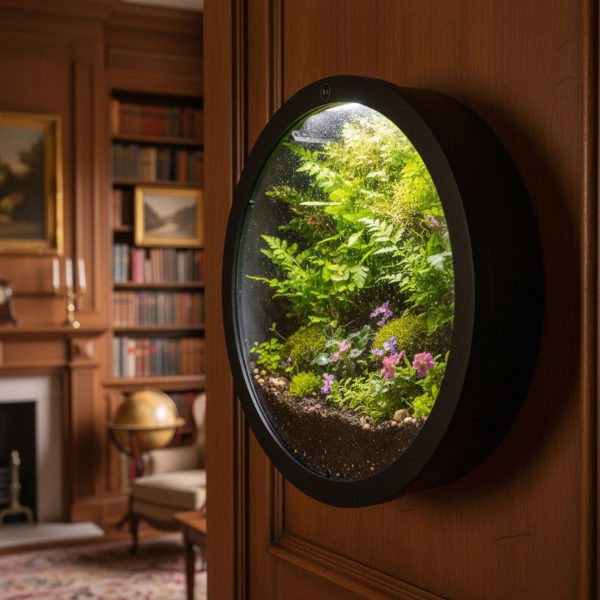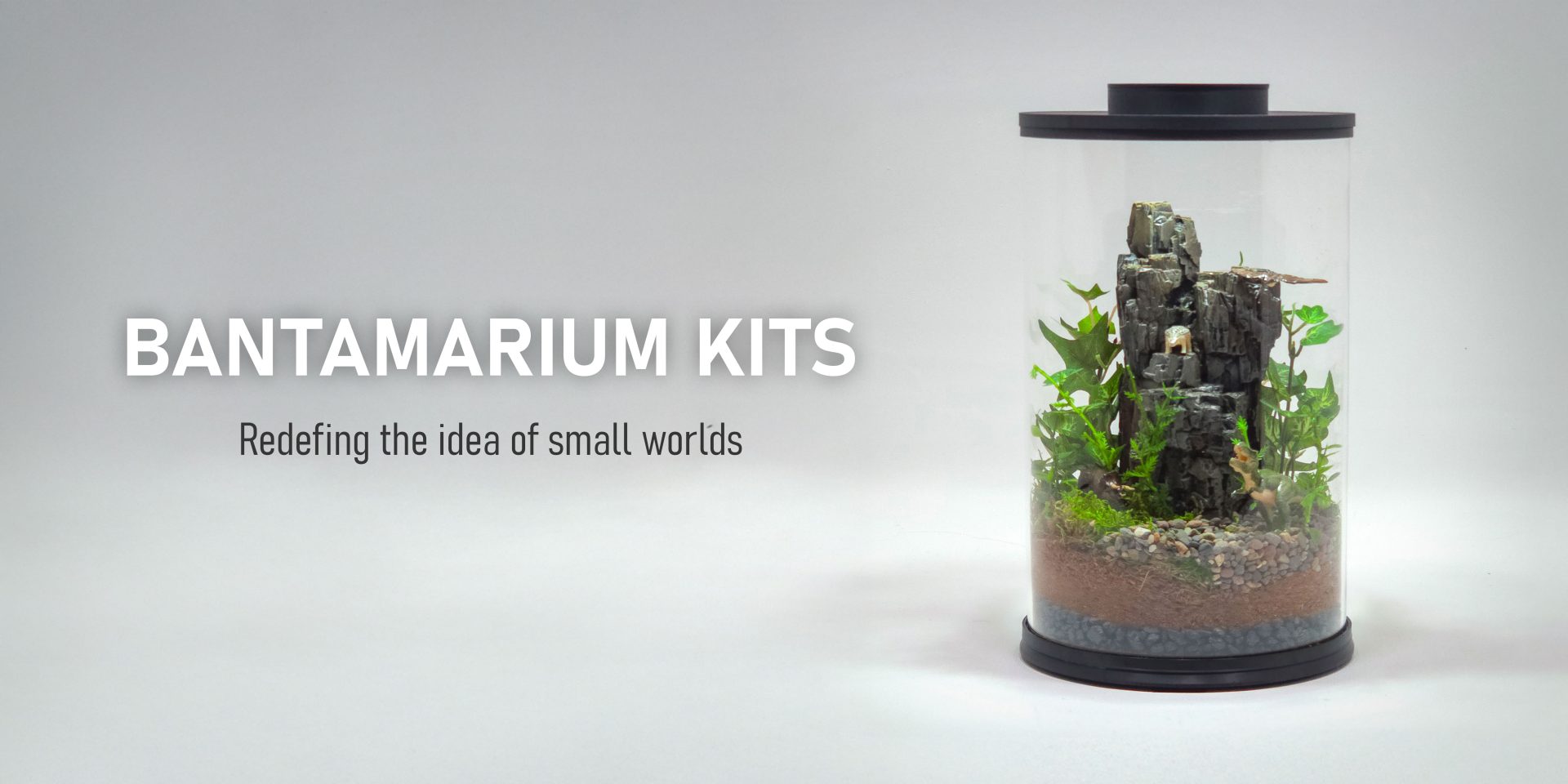Have you ever wanted to create and hold a complete, living world in your hands? That is the essence of a vivarium.
The term itself… derived from the Latin for “place of life”… describes a profound and rewarding hobby: the art of building a self-contained, miniature ecosystem.
This guide is your definitive starting point. Here, we will dive deep into what a vivarium truly is, explore the universal principles of building a healthy bioactive environment, and introduce the modern tools that can help you craft a stunning piece of nature that thrives on your desk or on your wall.
Table Of Contents:
ToggleWhat Is A Vivarium?
A vivarium, also commonly referred to as “vivaria”, is an enclosure made to house plants and/or animals. The viva part of the word comes from the Latin word vivus, meaning “living.”The word itself translates to “a place of life.” The plural form of the vivarium is vivaria.


Vivarium Vs Terrarium: What’s The Difference?
The key difference between a vivarium and a terrarium is simple. One has an established animal enclosed, and one does not. As a result, adding an inhabitant to a terrarium changes the enclosure to a vivarium or, at the very least, a bioactive terrarium.
It’s easy to mix up the two terms. Many popular terrariums today are complex systems based on the premise of a planter. If you’re here to build a land-dominant enclosure that could sustain a living animal, it will more than likely be bioactive, and you are at the right place.
The Heart of a Vivarium: The Bioactive Ecosystem
A vivarium is more than just a container with plants and animals; at its best, it is a bioactive ecosystem.
This means that every element inside works together in a self-sustaining cycle that mimics the balance of the natural world.
Instead of you cleaning the enclosure, the enclosure cleans itself. Understanding this concept is the key to creating a thriving, low-maintenance habitat.
A true bioactive system is built on three pillars: the substrate, the plants, and the pets, aka”clean-up crew.”
The Living Substrate
The foundation of any bioactive vivarium is its substrate. This isn’t just plain dirt; it’s a carefully constructed, multi-layered base designed to manage water and foster microbial life.
It typically includes a bottom drainage layer (like LECA or gravel), a barrier to prevent mixing, a layer of activated charcoal to filter impurities, and finally, a rich, organic substrate mix. This foundation holds moisture, provides nutrients for plants, and becomes the home for your clean-up crew.
The Naturalistic Flora
The plants in a vivarium do more than just look beautiful.
Their roots help to aerate the substrate, and through photosynthesis, they contribute to a healthy gas exchange within the enclosure.
They also provide crucial shelter, climbing opportunities, and a sense of security for any animal inhabitants, allowing them to express their natural behaviors.
The “Clean-Up Crew” (Detritivores)
This is the invisible workforce that makes the bioactive cycle possible.
A “clean-up crew” is a team of tiny, harmless invertebrates (called detritivores) that you introduce into the substrate.
The most common members are Springtails and Isopods (like Dwarf Whites or Dairy Cows). Their job is to consume any and all waste inside the vivarium… from animal droppings to fallen leaves and even mold.
They break down this waste, returning it to the soil as nutrients for the plants. They are the essential janitors that keep your ecosystem healthy, clean, and stable.


The Universal Principles of Building a Vivarium
While every type of vivarium is unique, they are all built upon the same foundational principles.
Mastering these universal concepts will give you the confidence to create any type of miniature ecosystem, from a simple terrarium to a complex, multi-environment paludarium.
Every successful build begins with four key considerations.
Choosing Your Tank
The enclosure, or “tank,” is the literal foundation of your world. The most important factors are size, security, and ventilation.
The tank must be large enough for your chosen inhabitants to live comfortably, be completely escape-proof, and offer appropriate ventilation to prevent the air from becoming stagnant.
Clear viewing panels are essential for observation, and easy access for maintenance is a crucial quality-of-life feature.


Substrate & Drainage
As we learned in the bioactive section, the substrate is far more than just dirt. Every vivarium, regardless of type, needs a well-planned foundation to manage water.
A proper drainage layer at the bottom is almost always necessary to prevent water from pooling and creating toxic conditions.
The substrate that goes on top must be tailored to the needs of your plants and animals… whether it’s a sandy, arid mix for a desert terrarium or a rich, moisture-retaining soil for a tropical jungle.
Light & Heat
All life needs energy, and in a vivarium, this is provided by light and heat. Your lighting solution must provide the correct spectrum and intensity for your chosen plants to photosynthesize and thrive.
For animal inhabitants, particularly reptiles and amphibians, providing a proper heat gradient (a warm basking spot and a cooler area) is often essential for them to regulate their body temperature.
This is typically achieved with a combination of overhead heat lamps and under-tank heating pads.
Plants & Hardscape
The “hardscape” refers to the non-living decorative elements in your vivarium, such as rocks, branches, and driftwood.
These elements are the bones of your design, creating the structure, texture, and topography of your miniature world.
They provide crucial hiding spots, basking areas, and climbing surfaces for your inhabitants.
Live plants are then added to flesh out the design, providing additional shelter, helping to maintain humidity, and completing the naturalistic look and feel of your ecosystem.
More about vivarium plants can be found here!


The Bantamarium Advantage: A Modern Approach
Understanding the principles of a great vivarium is the first step; having the right canvas is the next.
The Bantamarium ecosystem was engineered to be the ultimate modern vessel, providing a versatile, artistically designed, and endlessly expandable foundation that elevates the traditional vivarium into a piece of interactive art.
Modular by Design
Traditional vivariums are static. The Bantamarium is dynamic. Our entire ecosystem is built on the principle of modularity.
Lids for ventilation, integrated LED lighting, bases that create filtration sumps, and even functional add-ons like our DOCK system can all be swapped and combined.
This means a single Bantamarium can be reconfigured from a dry, arid terrarium to a high-humidity paludarium with a few simple changes, giving you a level of adaptability that no glass box can offer.
Designed for Display
We believe a vivarium should be a centerpiece. While traditional tanks are often hidden away, Bantamariums are designed to be showcased.
The artistic shapes of the Bantam C2 (circular) and Bantam R2 (rectangular) series are crafted to look like living portraits or shadow boxes, with integrated wall-mounting capabilities that transform your habitat into a piece of decor.
They are the perfect fusion of form and function, designed to bring your miniature world into the spotlight.


Limitless Expansion
Perhaps the greatest advantage is the ability to grow. Every Bantamarium features our signature V2-compatible ports, allowing you to seamlessly connect multiple enclosures together.
A single terrarium can evolve into a sprawling, multi-unit habitat. An ant colony’s first small nest can expand into a complex city of interconnected nests and outworlds.
With a Bantamarium, you are never limited to a single box; you are building a universe that can expand with your imagination.
Ready to find the perfect canvas for your project?
Choose Your World
You now understand the principles that govern every great vivarium and the modern tools that can bring your vision to life.
The Bantamarium ecosystem is a blank canvas, a foundation ready to become any world you can imagine.
The only question left is: what kind of world will you create? Will it be a lush, self-sustaining garden? A bustling underwater city? A slice of a misty shoreline?
The next step in your journey is to explore the different types of vivariums you can build. Our detailed directory will introduce you to each one.
Frequently Asked Questions
The main difference between a vivarium and a terrarium is that a vivarium is used to house living animals, whereas a terrarium is primarily used to house plants. Vivariums typically include a heating and cooling system, while terrariums may not. Additionally, while terrariums can often be made with any type of container, the walls of a vivarium need to be quite thick to provide temperature regulation and maintain the correct environment for the animals living inside.
The word “vivarium“ comes from Latin, meaning “place of life“, referring to a place to keep or study living organisms. It is used to refer to terrariums, aquariums, and other enclosures used to keep and observe plants and animals, oftentimes in a semi–natural habitat.
No, bugs are not necessary for a vivarium. Certain species of reptiles, amphibians, and other animals that live in vivariums may need insects as part of their diets, but they are not necessary for the vivarium itself.
A vivarium should be thoroughly cleaned every 4–6 weeks or as needed. This includes spot-cleaning any surfaces and removing uneaten food or waste. As part of the cleaning process, you should also check the temperature, humidity, and filtration system and make any necessary changes.
Yes, potting soil can be used in a vivarium, provided it has been sterilized. Before adding the soil to the vivarium, make sure it is thoroughly mixed with organic matter such as leaf litter and peat moss. In addition, the soil should be treated with an insecticide or fungicide to ensure it is free from diseases and pests.
Bioactive tanks can sometimes have a slightly earthy smell if not cleaned properly, however generally speaking they should not have an unpleasant odor.
High humidity in a vivarium can be caused by inadequate ventilation, over–watering, or other environmental factors such as temperature and exposure to sunlight. To lower the humidity in the vivarium, ensure it has adequate ventilation, and water only as needed, and adjust other environmental factors as needed.
To keep a vivarium humid, use a humidity gauge to monitor the humidity levels. Increase humidity levels by misting the vivarium with a spray bottle and placing water dishes, plants, live moss, and other moisture–holding elements inside. Install a humidifier inside the vivarium if needed to maintain humidity levels in warmer climates.
No, a drainage layer is not typically needed for a vivarium. However, it may be beneficial to add a layer of water–absorbing material beneath the substrate to prevent excessive moisture buildup.






